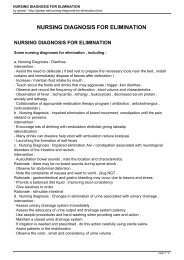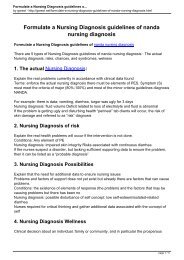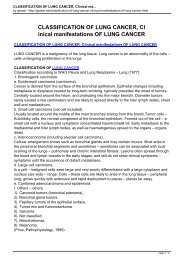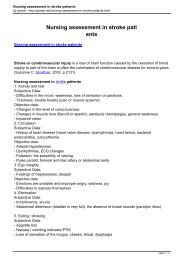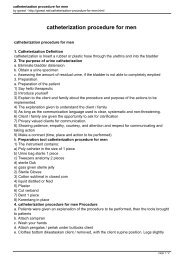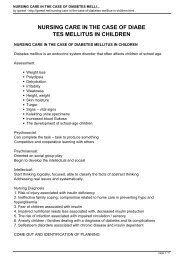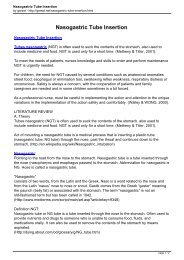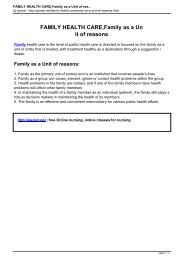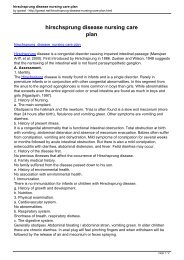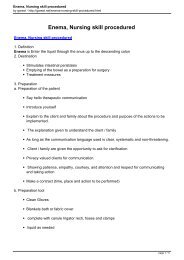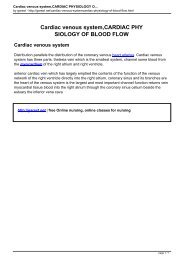CLINICAL cephalgia
Create successful ePaper yourself
Turn your PDF publications into a flip-book with our unique Google optimized e-Paper software.
<strong>CLINICAL</strong> <strong>cephalgia</strong><br />
by garest - http://garest.net/clinical-<strong>cephalgia</strong>.html<br />
<strong>CLINICAL</strong> <strong>cephalgia</strong><br />
<strong>CLINICAL</strong> <strong>cephalgia</strong><br />
There are some clinical manifestations <strong>cephalgia</strong>, among others<br />
a. Migraine<br />
Migraine is a complex phenomenon that has the characteristics of a particular time and severe<br />
headache attacks that occur repeatedly. The cause of migraines is not clearly known, but it can<br />
be caused by a primary vascular disorder that usually occurs in women, and many have a<br />
strong tendency in the family.<br />
Signs and symptoms of migraine on the result of cerebral cortical ischemia varying degrees.<br />
The attack began with the scalp artery vasoconstriction dam retinal and cerebral blood vessels.<br />
Intra and extracranial blood vessels dilated, which causes pain and discomfort.<br />
Classic migraine can be divided into three phases, namely:<br />
- Phase aura.<br />
Lasted approximately 30 minutes, and can provide an opportunity for patients to determine<br />
which drugs are used to prevent the attacks. Symptoms of this period is the impaired vision<br />
(glare), tingling, itching sensation on the face and hands, a little weak on the extremities and<br />
dizziness.<br />
Period aura is associated with vasoconstriction without pain that begins with early physiological<br />
changes. Reduced cerebral blood flow, with a loss of autoregulation laanjut and CO2<br />
responsiveness damage.<br />
- Phase headache<br />
Phase severe throbbing headache and incapacitated associated with photophobia, nausea and<br />
vomiting. Duration of this state varies, a few hours in a day or a few days.<br />
- recovery phase<br />
Period muscle contraction neck and scalp associated with local muscle pain and tension.<br />
Fatigue usually occurs, and the patient can sleep for a long time.<br />
b. Cluster Headache<br />
Cluster Headache pain is a form of vascular clod more common in men. The attack comes in<br />
the form of a pile or in groups, with excruciating pain and eye areas stricken face and temporal<br />
spread. Pain followed by watery eyes and nasal obstruction. The attack ends from 15 minutes<br />
to 2 hours and decreased strength gained.<br />
c. Tension Headache<br />
Physical and emotional stress can cause contraction of the muscles of the neck and scalp,<br />
which causes tension headaches. The characteristics of this headache feeling no pressure on<br />
the forehead, temples, or back of the neck. It is often depicted as a “heavy burden of covering<br />
the head”. These headaches tend to be chronic rather than weight. Patients requiring sobriety,<br />
and this condition is usually an unspoken fear. Symptomatic relief may be given to the location<br />
page 1 / 2
Powered by TCPDF (www.tcpdf.org)<br />
<strong>CLINICAL</strong> <strong>cephalgia</strong><br />
by garest - http://garest.net/clinical-<strong>cephalgia</strong>.html<br />
of heat, massage, analgesics, antidepressants and muscle relaxants.<br />
http://garest.net | free Online nursing, online classes for nursing<br />
page 2 / 2




